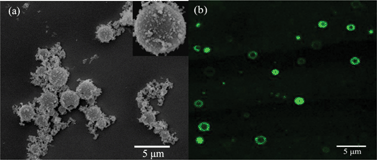Biomimetic synthesis of silica hollow spheres using poly (l-lysine) and mechanism research†
Abstract
The biomimetic synthesis of

* Corresponding authors
a
Department of Chemistry, Science Faculty, Shantou University, Shantou, China
E-mail:
xzhang@stu.edu.cn
b
The Key Laboratory of Low-carbon Chemistry & Energy Conservation of Guangdong Province, The State Key Laboratory of Optoelectronic Materials and Technologies, Sun Yat-sen University, Guangzhou, China
E-mail:
stsspk@mail.sysu.edu.cn
The biomimetic synthesis of

 Please wait while we load your content...
Something went wrong. Try again?
Please wait while we load your content...
Something went wrong. Try again?
N. Li, X. Zhang, Q. Wang, F. Wang and P. Shen, RSC Adv., 2012, 2, 3288 DOI: 10.1039/C2RA00019A
To request permission to reproduce material from this article, please go to the Copyright Clearance Center request page.
If you are an author contributing to an RSC publication, you do not need to request permission provided correct acknowledgement is given.
If you are the author of this article, you do not need to request permission to reproduce figures and diagrams provided correct acknowledgement is given. If you want to reproduce the whole article in a third-party publication (excluding your thesis/dissertation for which permission is not required) please go to the Copyright Clearance Center request page.
Read more about how to correctly acknowledge RSC content.
 Fetching data from CrossRef.
Fetching data from CrossRef.
This may take some time to load.
Loading related content
